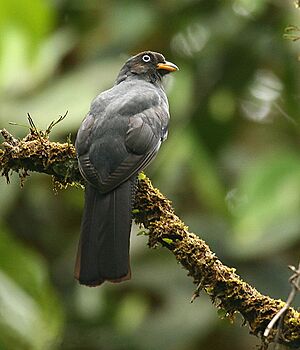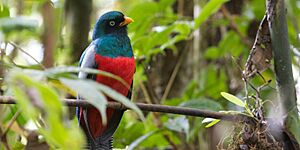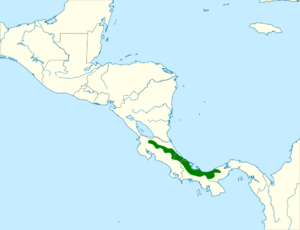Lattice-tailed trogon facts for kids
Quick facts for kids Lattice-tailed trogon |
|
|---|---|
 |
|
| Female in Costa Rica | |
 |
|
| Male in Costa Rica | |
| Conservation status | |
| Scientific classification | |
| Genus: |
Trogon
|
| Species: |
clathratus
|
 |
|
The lattice-tailed trogon (Trogon clathratus) is a beautiful bird that belongs to the same family as the famous quetzals. These colorful birds are found in the forests of Costa Rica and Panama. They are known for their striking looks and unique calls.
Contents
What Does It Look Like?
The lattice-tailed trogon is about 30 cm (12 in) long. That's about the length of a ruler! It weighs around 130 g (4.6 oz), which is similar to a small apple.
Male vs. Female
Male trogons are very colorful. They have a bright yellow beak and a whitish eye. Their face, chin, and throat are black. The top of their head, back, and chest are a shiny, iridescent green. Their belly and underside are a pretty rosy red. Their wings look gray from a distance, but up close, you can see fine black and white patterns. The top of their tail is bluish-green, and the underside is slate gray with thin white stripes.
Female trogons are a bit different. Instead of the bright green, their body is mostly slaty gray. Their chest might have a hint of olive color. The top part of their beak is dark.
Where Does It Live?
The lattice-tailed trogon lives in the warm, wet forests of Costa Rica and western Panama. You can find them on the Caribbean side of Costa Rica and sometimes on the Pacific side in Panama.
They like to live in the middle and lower parts of tall, old trees in humid forests. They are usually found deep inside the forest. However, you might also spot them at the edges of the forest or in shady, partly open areas. They live at elevations between 90 and 1,360 m (300 and 4,500 ft) above sea level. They sometimes move to lower areas when it's very rainy, but they almost never go down to the flat lowlands.
How It Lives
What Do They Eat?
Lattice-tailed trogons mostly eat fruits and large insects. Sometimes, they also snack on small frogs and lizards.
Reproduction and Nests
The breeding season for these birds is from February to May. They make their nests in holes they dig out of rotten trees or dead tree stumps. Sometimes, they even nest inside a termitarium (a termite nest) that's built in a tree. Their nests are usually found about 5 and 8 m (16 and 26 ft) above the ground.
Their Song
The lattice-tailed trogon has a very distinct song. It's a fast series of about 15 loud, clear "kwa" notes. The song starts low, gets louder and higher in the middle, and then becomes faster, softer, and lower towards the end.
Conservation Status
The IUCN (International Union for Conservation of Nature) has listed the lattice-tailed trogon as a species of "Least Concern." This means they are not currently in danger of extinction. However, their population is believed to be decreasing.
Even though they are not critically endangered, their habitat is being destroyed in many areas. Because of this, experts believe it's important to keep a close eye on their numbers and protect the forests where they live.


